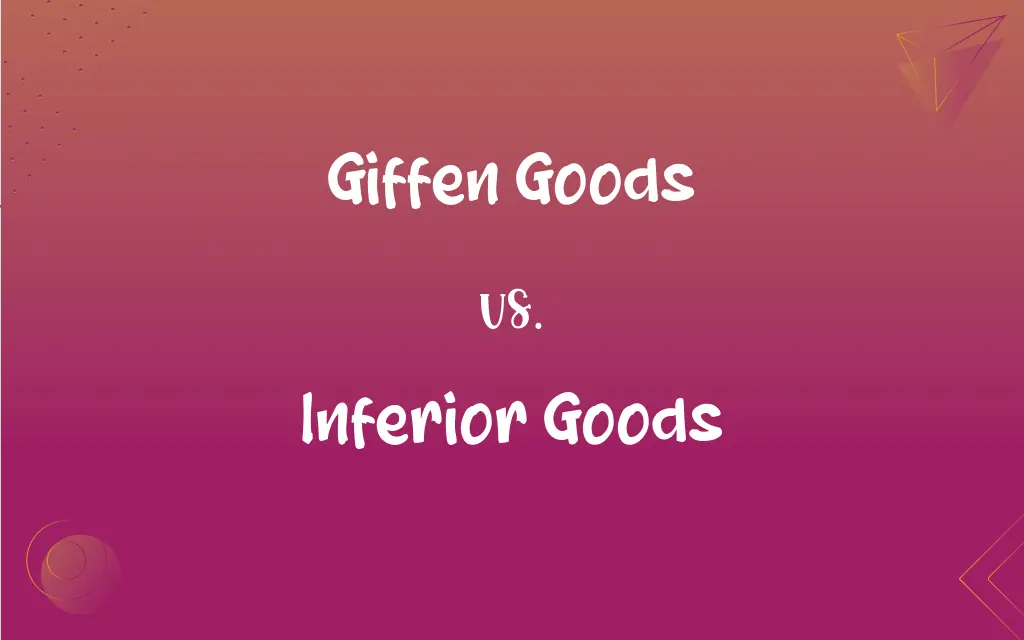Giffen Goods vs. Inferior Goods: What's the Difference?
Edited by Aimie Carlson || By Harlon Moss || Published on November 13, 2023
Giffen goods are rare products where demand increases as price increases, while inferior goods are items for which demand decreases as consumer income rises.

Key Differences
Giffen goods defy typical economic logic where increased price usually leads to decreased demand. Instead, these goods see an increase in demand as their prices rise, often due to a lack of viable substitutes.
Inferior goods are products that consumers turn away from as their incomes increase, opting for higher-quality alternatives. These goods see a decline in demand as consumer purchasing power grows.
The behavior of giffen goods is an anomaly in economics, making them rare and interesting cases for study. They often pertain to essential commodities in specific contexts.
Conversely, inferior goods are quite common in the market. They are not necessarily poor in quality but are considered less desirable as consumers' financial situations improve.
Understanding the dynamics of giffen goods and inferior goods is crucial for businesses and economists, as it helps in predicting consumer behavior and market trends.
ADVERTISEMENT
Comparison Chart
Price-Demand Relationship
Demand increases with price increase
Demand decreases with income increase
Consumer Behavior
Buy more when price rises
Buy less as income rises
Rarity
Rare in markets
Common in markets
Examples
Staple foods in low-income areas
Generic brands, budget items
Economic Significance
Anomaly in economic theory
Regular occurrence in consumer behavior
ADVERTISEMENT
Giffen Goods and Inferior Goods Definitions
Giffen Goods
Essential Commodities.
In certain economies, basic grains can be giffen goods.
Inferior Goods
Quality Perception.
Off-brand electronics are seen as inferior goods.
Giffen Goods
Lack of Substitutes.
Rice in some regions acts as a giffen good.
Inferior Goods
Income-Dependent Demand.
As incomes rose, bus travel became an inferior good.
Giffen Goods
Unique Economic Phenomenon.
Giffen goods contradict standard demand curves.
Inferior Goods
Substitute for Premium Goods.
Instant noodles are inferior goods compared to restaurant meals.
Giffen Goods
Price Anomaly.
Potatoes during the Irish Famine were giffen goods.
Inferior Goods
Budget Alternatives.
Generic cereal brands are often inferior goods.
Giffen Goods
Demand Increase with Price.
As bread prices rose, it became a giffen good.
Inferior Goods
Demand Shift with Wealth.
Used cars are inferior goods for many.
FAQs
Why do giffen goods defy normal economics?
Because they exhibit increased demand with higher prices.
Are giffen goods common?
No, they are rare and specific to certain conditions.
What impact does economic growth have on inferior goods?
Typically leads to decreased demand for them.
Do inferior goods imply poor quality?
Not necessarily, it's more about consumer preference.
What factors create giffen goods?
Lack of substitutes and essential nature of the product.
Can a luxury item be an inferior good?
Rarely, as inferior goods are usually budget-friendly alternatives.
Do all low-income consumers buy inferior goods?
Not necessarily, it depends on individual preferences.
Can a good be both giffen and inferior?
Unlikely, as their defining characteristics are different.
How do marketers approach inferior goods?
By emphasizing value and affordability.
What role does income elasticity play in giffen goods?
It's crucial as demand increases despite rising prices.
What makes a good 'inferior'?
Decreased demand as consumer income increases.
Can any product become an inferior good?
Yes, if consumers prefer alternatives as their income grows.
Is the concept of giffen goods universally accepted?
It's debated but recognized in specific economic contexts.
Is consumer awareness a factor in buying inferior goods?
Yes, as informed consumers may choose alternatives as income grows.
What defines a giffen good?
Increased demand with rising prices, despite economic norms.
Can a brand change its status from inferior good?
Yes, by improving quality or changing market perceptions.
Do giffen goods exist in modern economies?
They're rare but can be found in specific market segments.
Can government policy create giffen goods?
Indirectly, through subsidies or market interventions.
Are giffen goods always essential commodities?
Mostly, as their demand persists despite price increases.
Is brand loyalty a factor in inferior goods?
Yes, as some consumers may shift brands with increased income.
About Author
Written by
Harlon MossHarlon is a seasoned quality moderator and accomplished content writer for Difference Wiki. An alumnus of the prestigious University of California, he earned his degree in Computer Science. Leveraging his academic background, Harlon brings a meticulous and informed perspective to his work, ensuring content accuracy and excellence.
Edited by
Aimie CarlsonAimie Carlson, holding a master's degree in English literature, is a fervent English language enthusiast. She lends her writing talents to Difference Wiki, a prominent website that specializes in comparisons, offering readers insightful analyses that both captivate and inform.
































































